Madagascar ctd: Kirindy, Kianjavato and Ranomafana, 2022
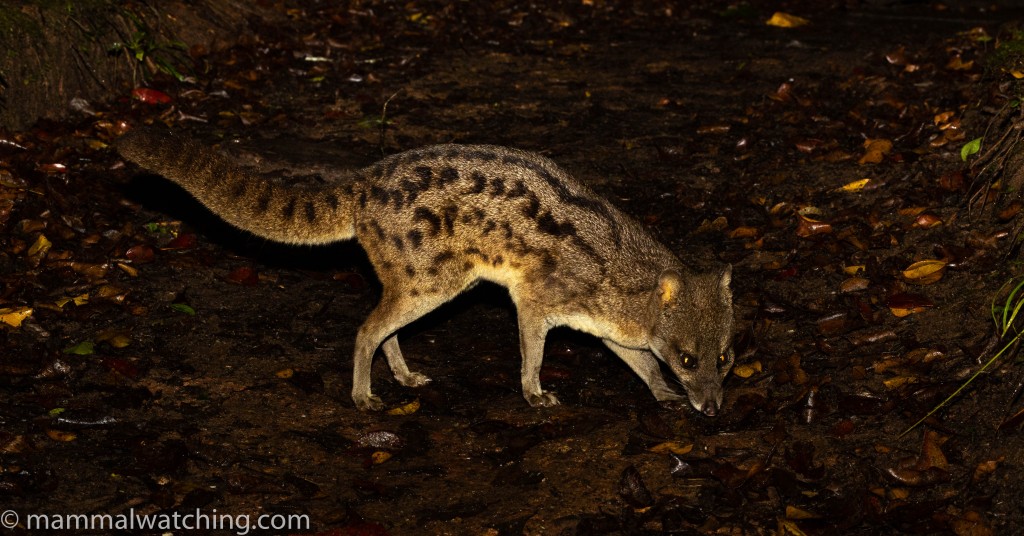
Fanaloka (Fossa fossana)
This is an addendum to last week’s report covering my 12 days in Northern Madagascar. Our trip through the north was the main event but how could I resist adding on a few more days to search for two more species: a Fossa, one of my top 21 species to see; and a Sucker-footed Bat, which would give me a new mammal family. Kianjavato Forest – the Sucker-footed Bat location – would also provide a backup chance to see an Aye-aye if we dipped in the north.
Patrick Richard and I came up with a plan for an intensive few days. We would fly from Tana to Morondava and drive the three hours to Kirindy to look for Fossas. From Kirindy an 18 hour drive would get us to Kianjavato Forest for the Sucker-footed Bats. And then it was just a 14 hour drive back to Tana, via Ranomafana National Park, and my flight home.
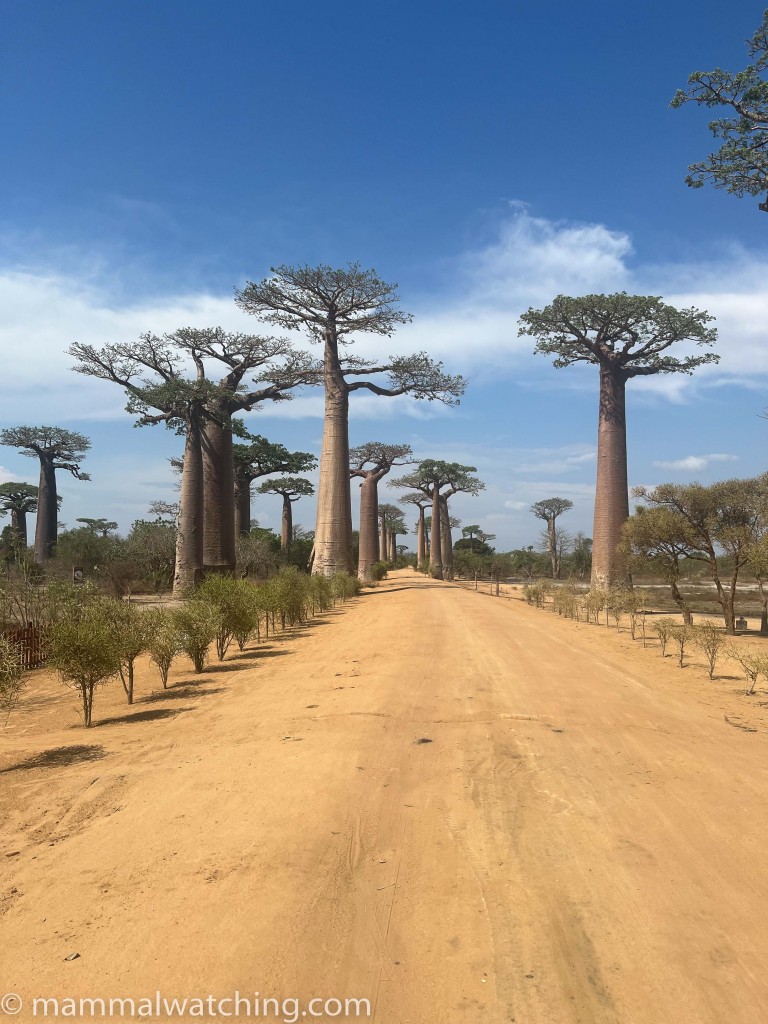
Avenue des Baobabs, between Morondava and Kirindy
Kirindy National Park
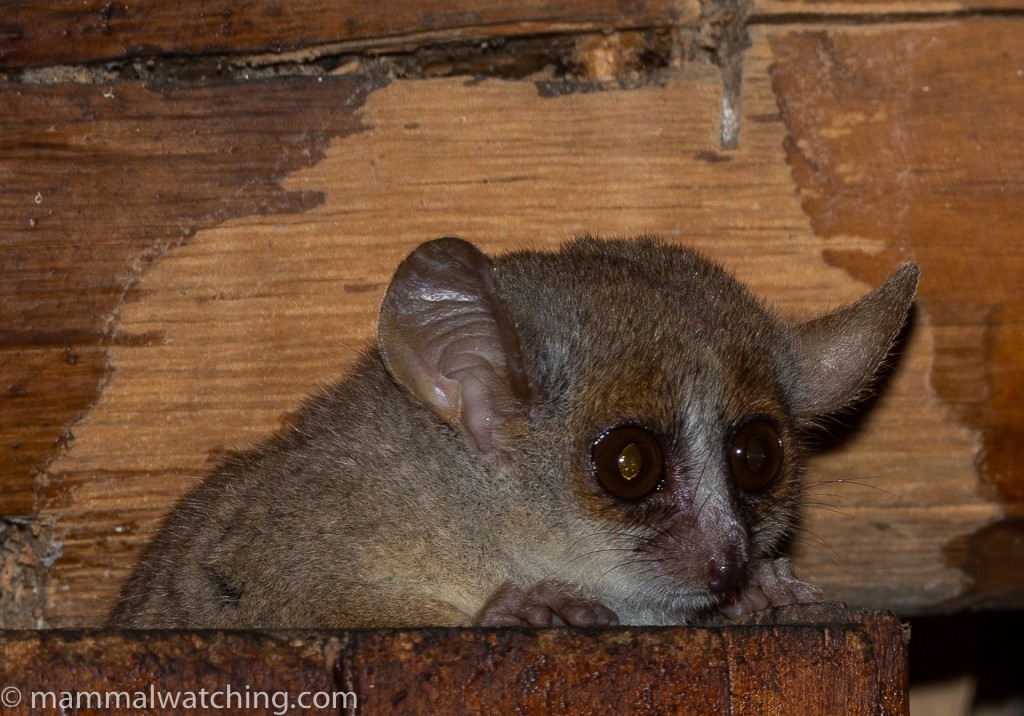
Grey Mouse-lemur (Microcebus murinus)
I visited Kirindy in 2010 and loved it, even if I didn’t see a Fossa. Back then it seemed Fossas were almost ubiquitous there and I left feeling unlucky.
But things have changed. It seems that time and COVID have not been kind to the mammals of Kirindy, and even before I arrived I noticed large areas of nothing that I am pretty sure were forest ten years ago.
When I arrived I was told that Fossas were not reliable any more. One or more animals was being seen every few days in October but other than that they had been scarce all year. Hopefully this will change as more tourists visit and the Fossas learn that camp is a reliable food source. I also learned that Madame Berthe’s Mouse Lemur – the world’s smallest primate – had not been seen close to the lodge in a “long time”.
The lodge was a lot busier than I remember. In January 2011 I think I had the place to myself. But in November 2022 there were at least 15 other people staying. We were all expected to head off at dusk, en masse, to take a night walk in the same location. I have no idea whether there was any logic behind this.
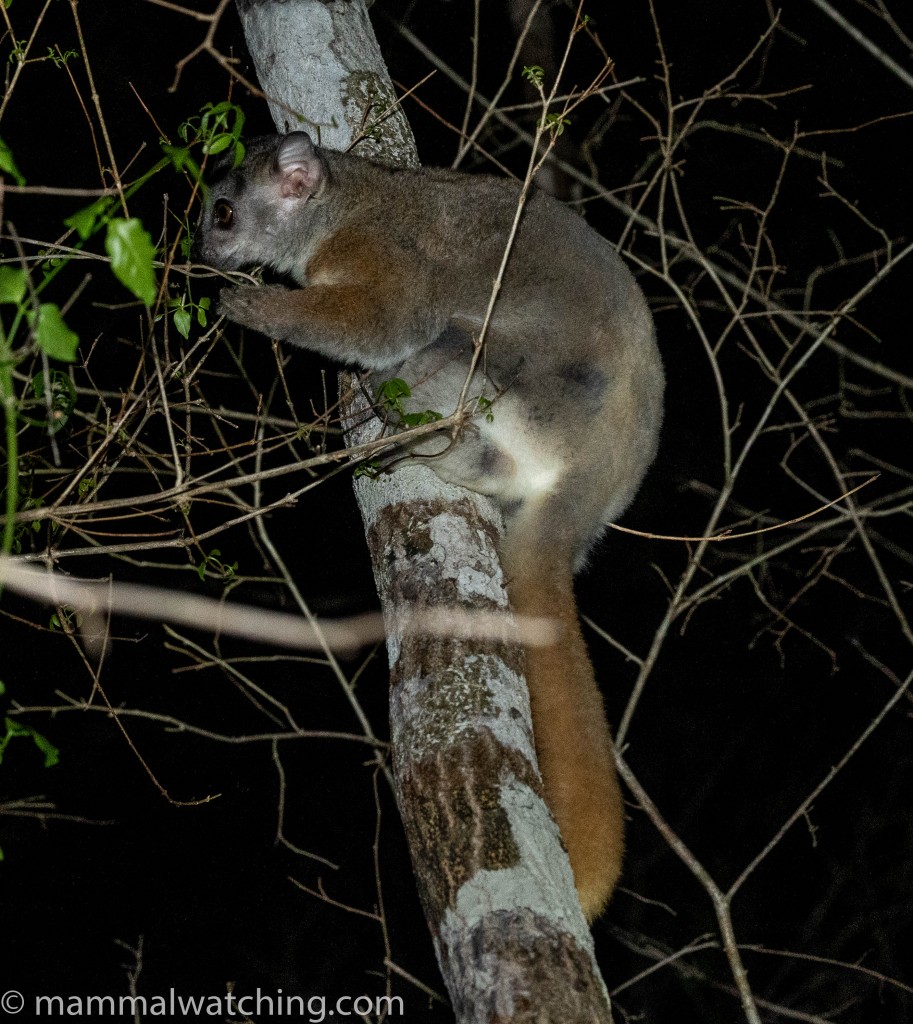
Red-tailed Sportive Lemur (Lepilemur ruficaudatus)
I was Fossa-focused during my 2 nights there. From what I could gather the last sighting was of an animal behind the kitchen one evening a few days before I arrived.
I spent most of my time patrolling the lodge grounds but I did take two night walks. My main nocturnal target was Coquerel’s Giant Mouse Lemur. We dipped. My excellent guide – Odilon – tried hard for them and knew the particularly trees to focus on. He said he sometimes saw several in a night but could then go weeks without seeing any.
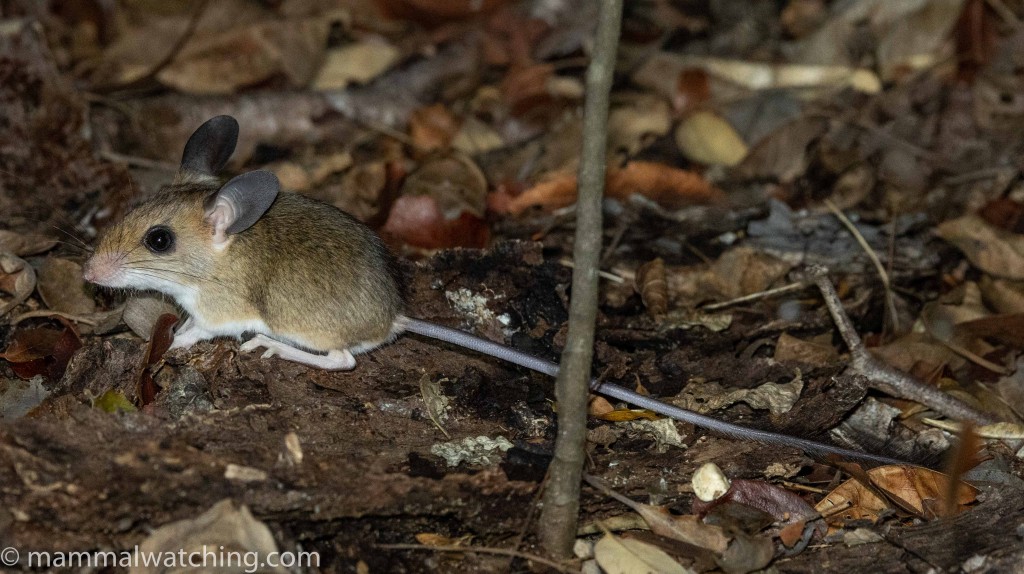
Western (Bastard) Big-footed Mouse (Macrotarsomys bastardi)
The walks were productive but the only new species for me were several of these wonderfully named Bastard (or Western Big-footed) Mice. I imagine one gave a particularly nasty bite to the person who got to name it…I picture a Far Side Cartoon with the mouse hanging off of a biologist’s thumb, captioned: “Carstairs! Scratch that name… Forget Splendid Mouse … I am going with Bastard.”
(NB. My Northern Madagascar Report included a photo of an unidentified rat in Ambanja that we initially thought might be from the same genus. But the tail of that animal looks completely different.)
Walking the trails at night we saw Red-tailed Sportive Lemurs, plenty of Grey Mouse Lemurs (including one living inside the lodge restaurant), Fat-tailed Dwarf Lemurs and Pale Fork-marked Lemurs. All of which I saw in 2011.
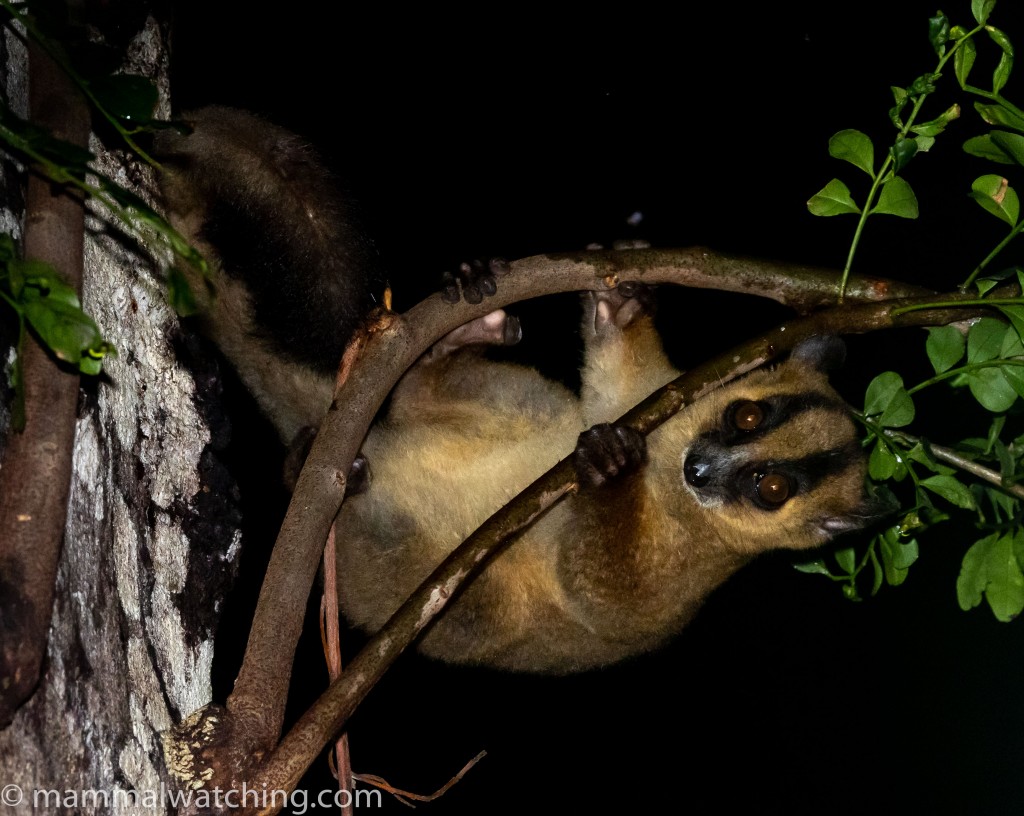
Pale Fork-marked Lemur (Phaner pallescens)
We also saw a Common Tenrec running at speed away from us and a sleeping Verreaux’s Sifaka.
Kirindy is famous for two nocturnal mammals: the fabulous Giant Jumping Rat and Madame Berthe’s Mouse Lemur, the smallest primate in the world.
The rats are still there, though I did not make a special effort to see them again. The guides know where they den and can take you out. But, as I said earlier, the mouse lemur has not been seen close to the lodge in some time. Why? Perhaps habitat clearance close to the lodge had an effect. And Odilon wondered hunting pressure on larger species might have upset the ecological balance.
That said information from guides in Madagascar can be contradictory (or misunderstood by people like me!). Look at the first comment below this report from Derek Schuurman who was in Kirindy a month before me and did see both a Fossa and Madame Berthe’s Mouse Lemur. He was told the latter’s presence can be affected by some species of insect.
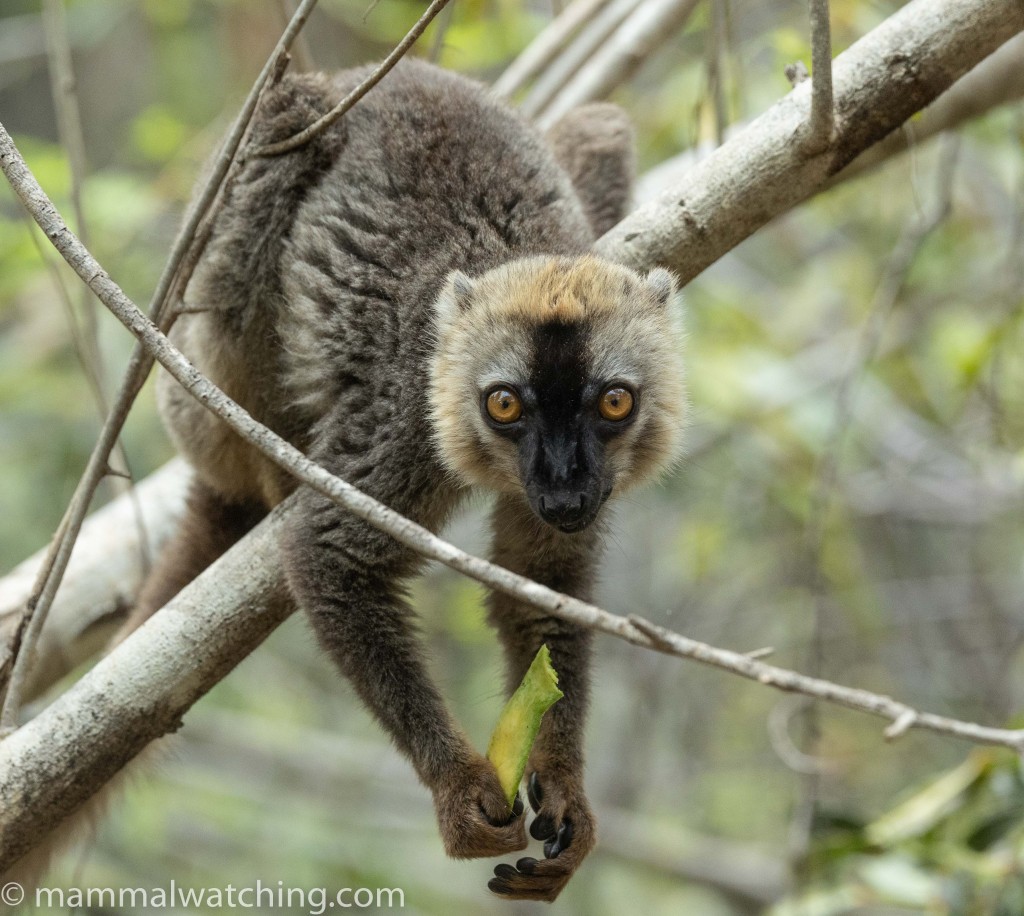
Red-fronted Brown Lemur (Eulemur rufifrons)
During the day I wandered around the lodge in search of Fossas. There were usually some Red-fronted Brown Lemurs hanging around.
We spent the first hour of two mornings at Akiba Lodge, about half an hour from Kirindy Lodge. This is a lovely new camp that was not quite ready to open but were able to give me breakfast. If I return to Kirindy I would stay here.
We drove to Akiba after learning that a Fossa was visiting each morning at 7am. It was seen the day I arrived. But not the following two mornings when I was there. Fossas are now, officially, a bogey beast.
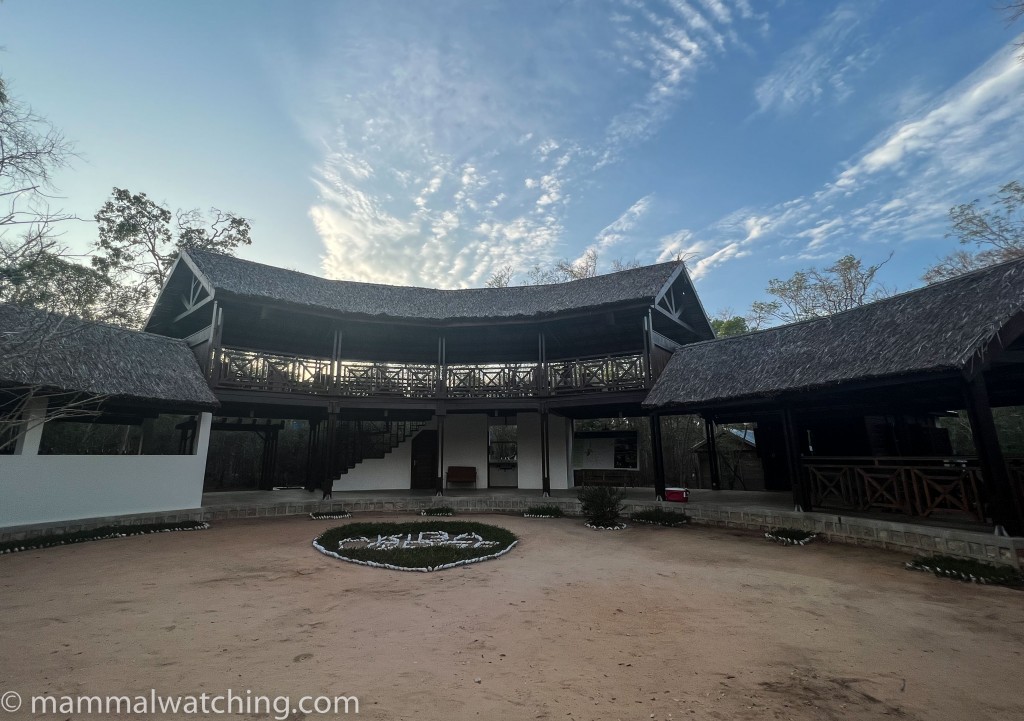
Akiba Lodge
There were Verreaux’s Sifakas in the lodge garden along with a roosting Red-tailed Sportive Lemur. One of the lodge guides claimed Madame Berthe’s Mouse Lemurs are still seen regularly at night here.
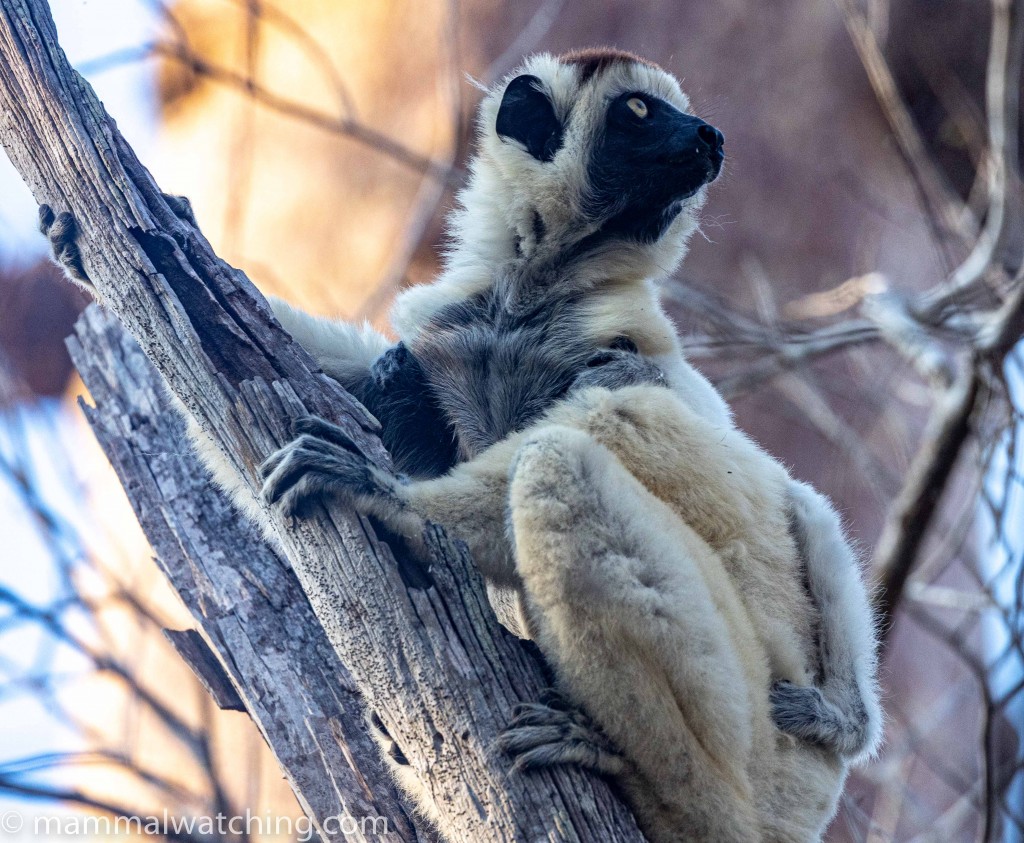
Verreaux’s Sifaka (Propithecus verreauxi)
We left Kirindy, Fossa-less, and drove for a day and half to Kianjavato Forest, breaking the journey overnight in the town of Antsirabe.
Kianjavato Forest
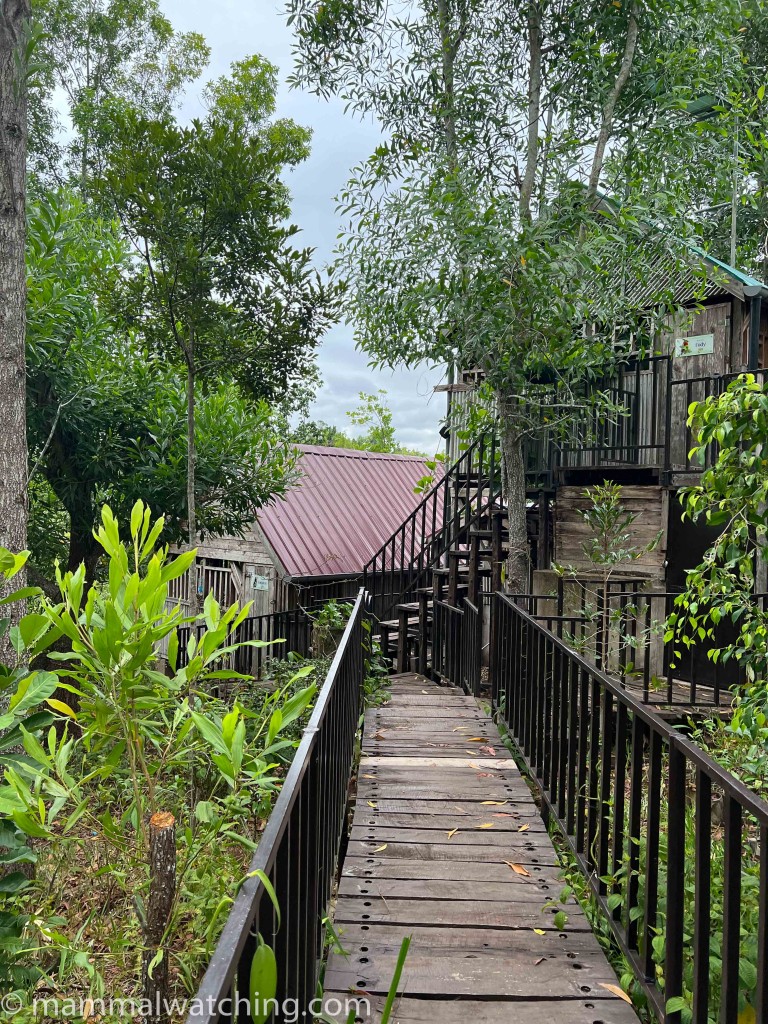
Kianjavato camp
I spent just one night here in a simple camp and I loved the place.
Kianjavato Forest is being run as a conservation project that is doing all sorts of inspiring things for the lemurs and the local community, including planting millions of trees that are either lemur friendly, or a source of timber or fruit.
Nine species of lemur live in the forest including some Greater Bamboo Lemur, Black and White Ruffed Lemur and Aye-aye. Some of the Aye-ayes are radio-collared and Ian Thompson’s report gives details of his encounter with one.
But my main goal, as I had seen Aye-aye so well in Daraina, were the Eastern Sucker-footed Bats that Mac Hunter had seen in 2019. The bats can usually be found easily in the daytime at their roosting sites.
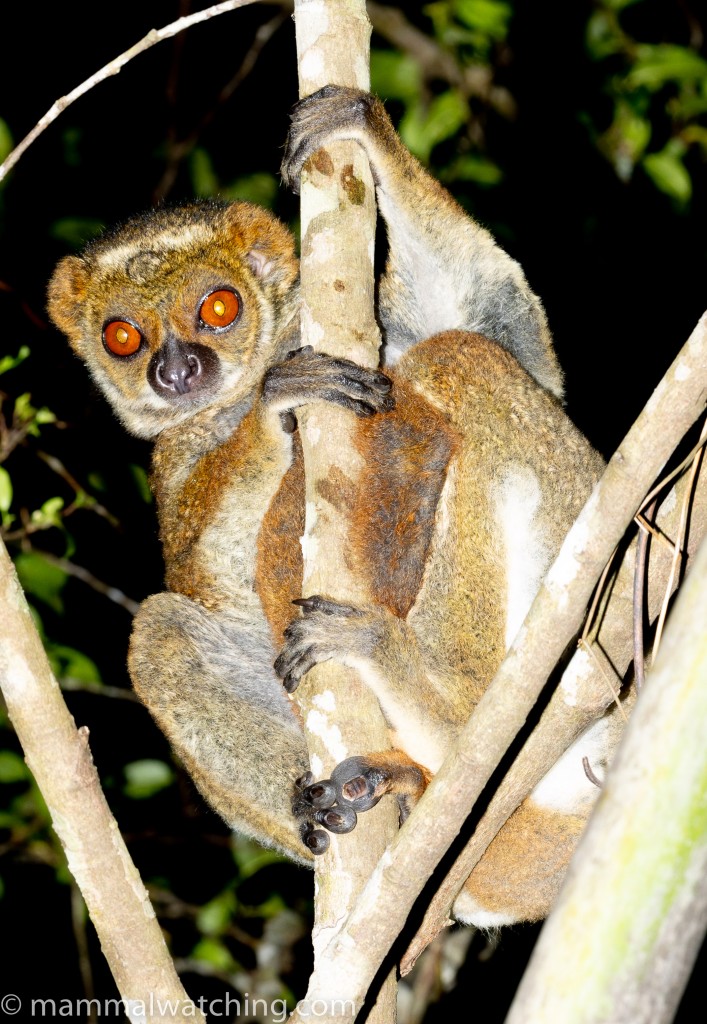
Peyrieras’ Woolly Lemur (Avahi peyrierasi)
We arrived late in the afternoon and took a productive night walk. A small group of Peyriera’s Woolly Lemurs was a surprise and a lifer. We also saw several dwarf lemurs. The jury is still out on which species occurs in Kianjavato though it is thought likely to be Geoffroy’s Dwarf Lemur.
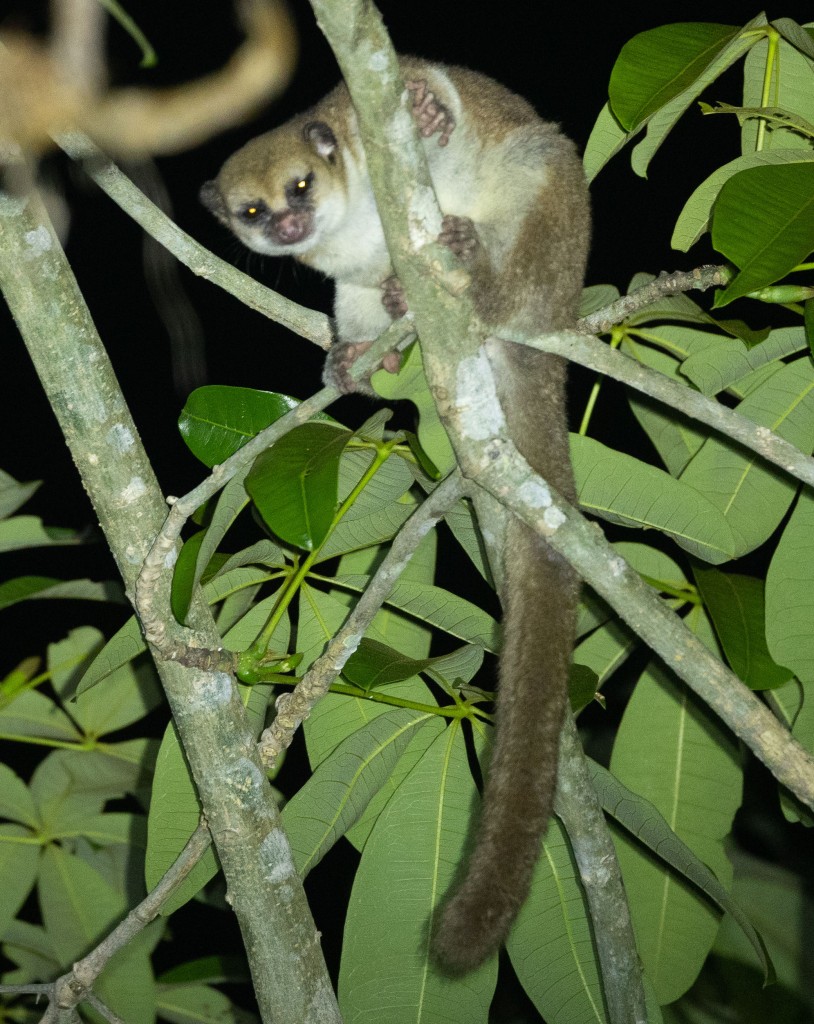
possible Geoffroy’s Dwarf Lemur (Cheirogaleus majori)
I was searching for the hyper local – described only in 2006 – Jolly’s Mouse Lemur, which we finally spotted emerging from a curled up Traveller’s Palm leaf. My second lifer of the evening.
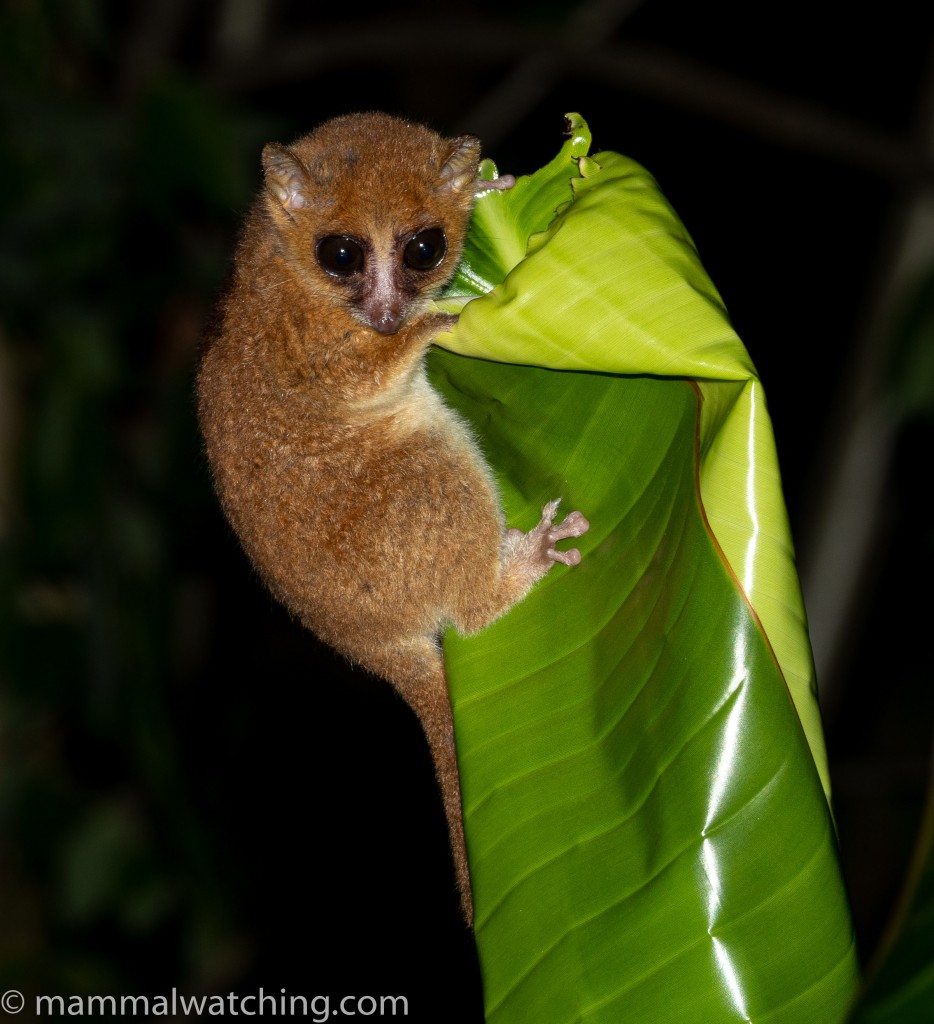
Jolly’s Mouse Lemur (Microcebus jollyae)
Close to the forest entrance we got a good look at this Greater Hedgehog Tenrec.
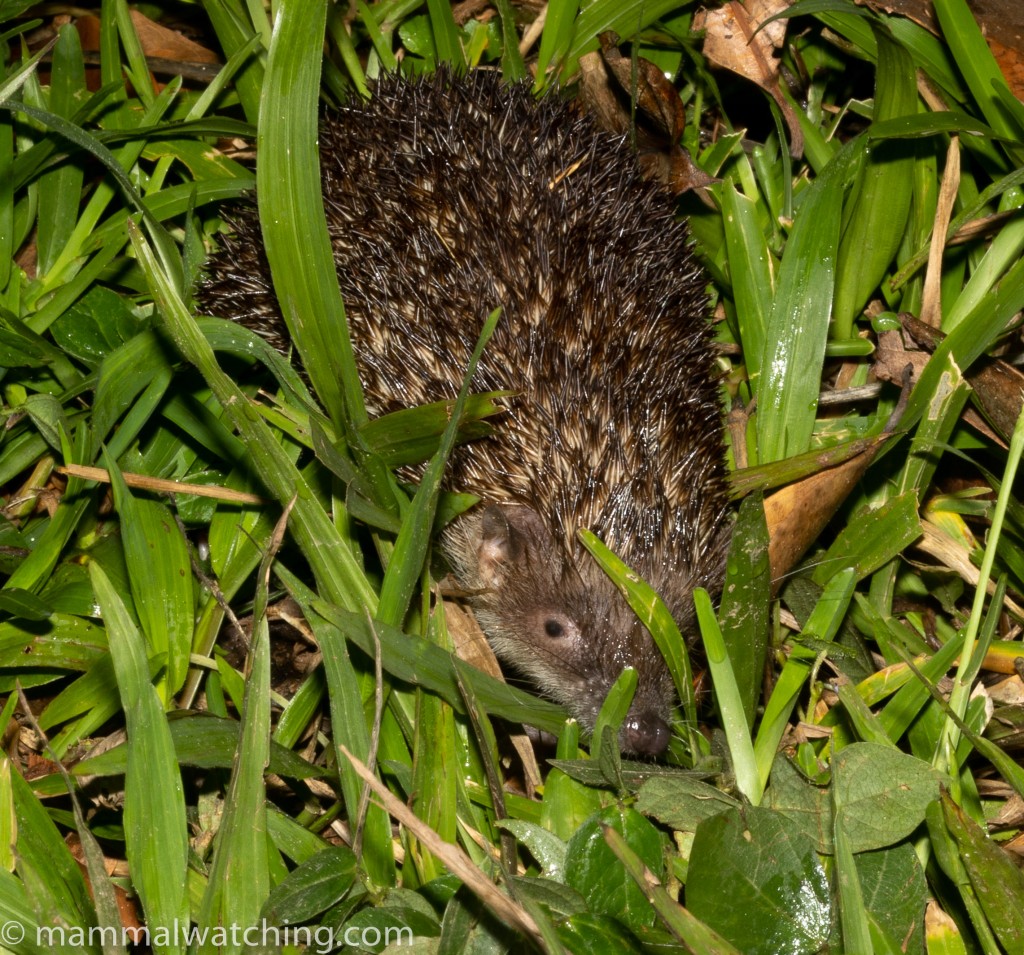
Greater Hedgehog Tenrec (Setifer setosus)
Back at the accommodation my guide – Dadah – showed us a few Peter’s Sheath-tailed Bats roosting in an empty building. Lifer number three.
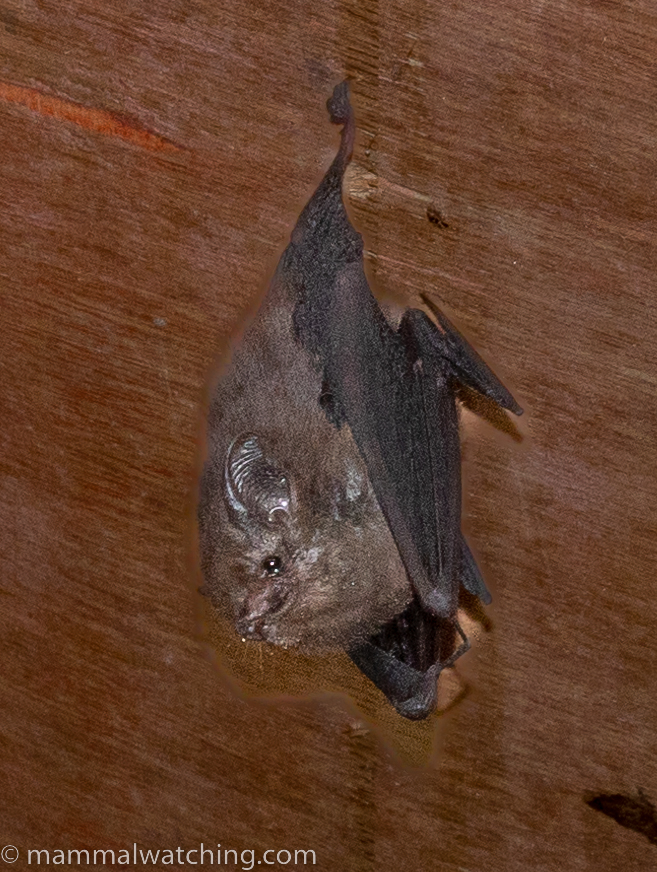
Peter’s Sheath-tailed Bat (Paremballonura atrata)
The following morning it took Ranto, another guide, just 20 minutes to find a roost of the fabulous Eastern Sucker-footed Bats. The guides know which Traveller’s Palm trees to look in. Groups of bats roost together inside curled up leaves.
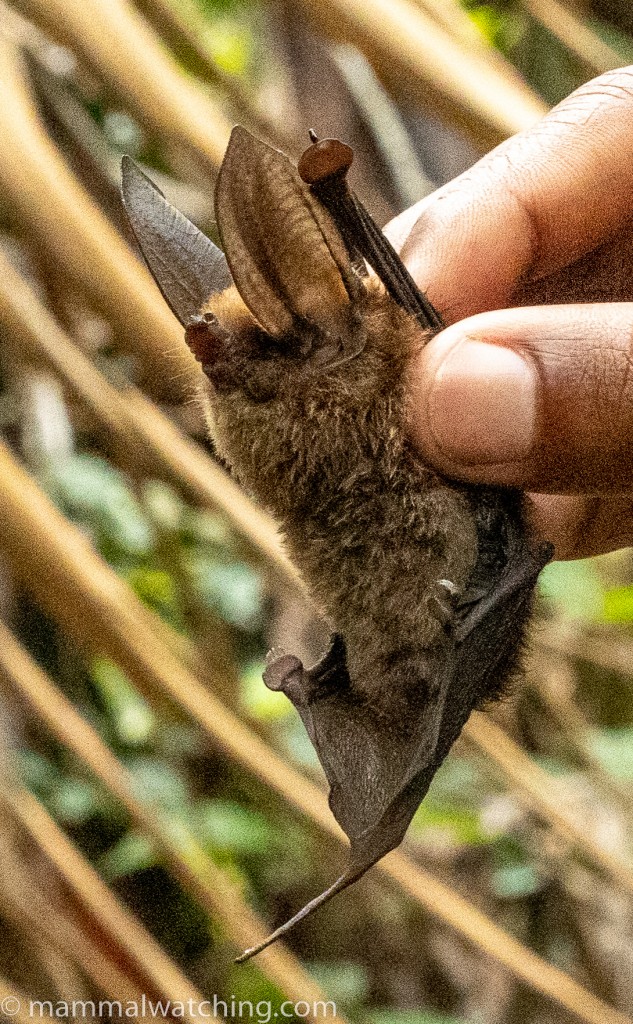
Eastern Sucker-footed Bat (Myzopoda aurita)
A fantastic bat and not just a lifer but a new mammal family too.
We heard Black and White Ruffed Lemurs calling as we returned to the car. This is quite a hard species to see and so, along with the Aye-aye, an extra reason to add Kianjavato to an itinerary.
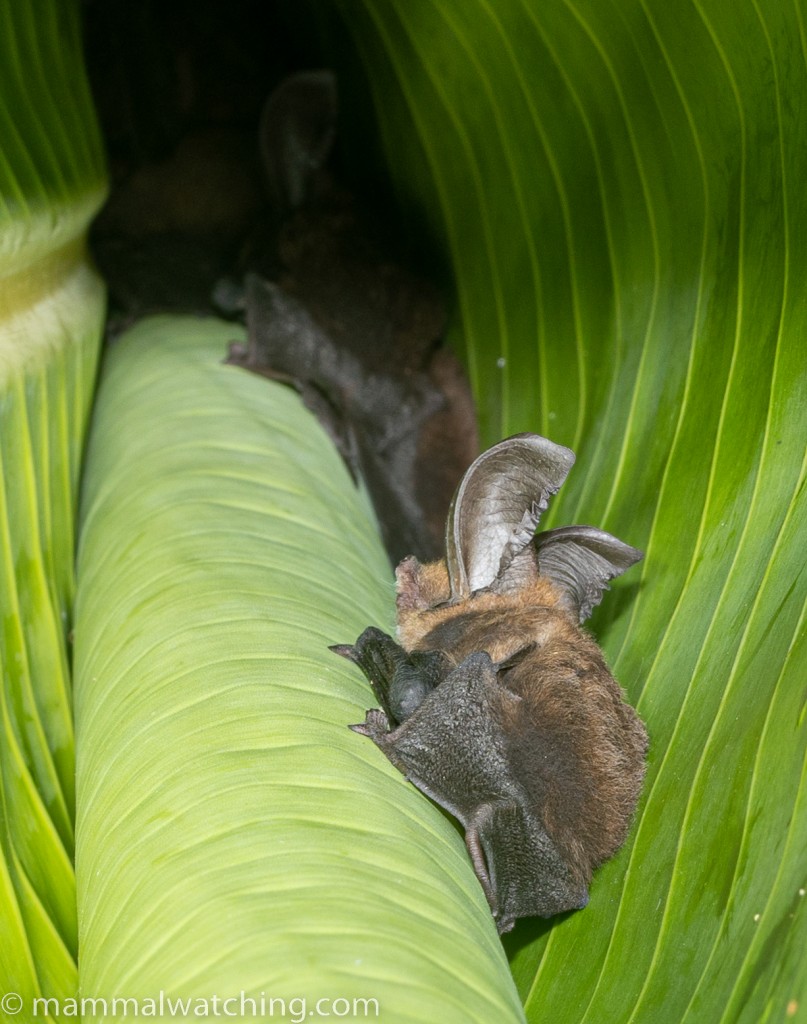
Eastern Sucker-footed Bat (Myzopoda aurita)
Ranomafana National Park
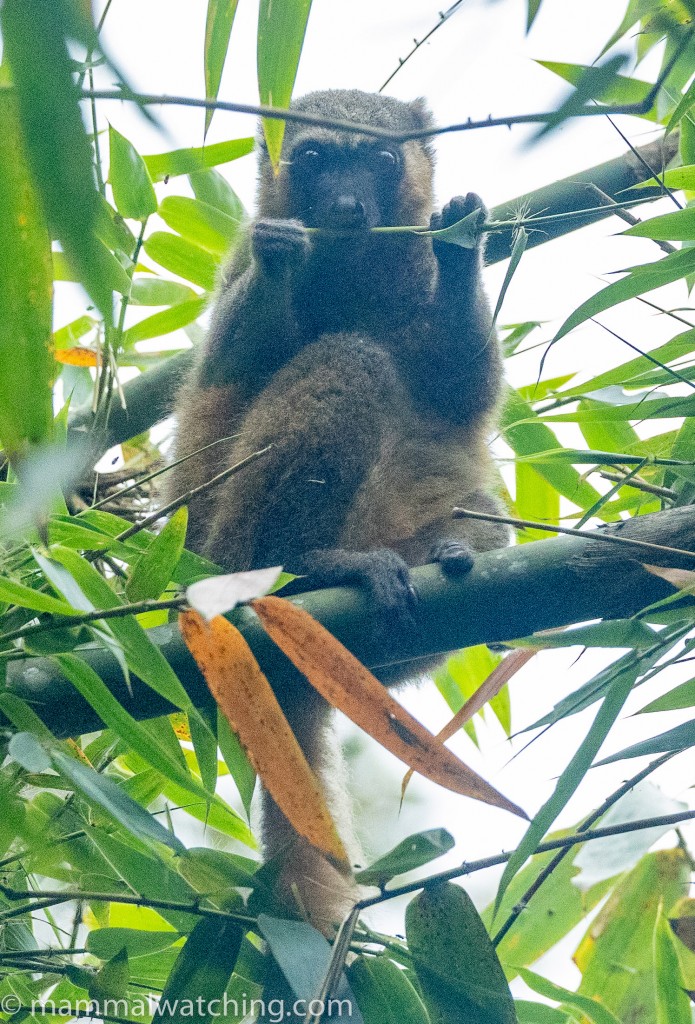
Golden Bamboo Lemur (Hapalemur aureus)
Ranomafana National Park is only a couple of hours from Kianjavato. It is also Patrick’s home base so naturally I wanted to stop in to the park for a day on my way back to Tana.
I visited here in 2011 and had thought I had cleaned up on most of the species I could reasonably expect to see. But after talking to Patrick I realised there was a lot more still to find. Of course there was. This is Madagascar.
Top of my hit last was Fanaloka. A beautiful small carnivore that Patrick sees “quite often” when camping inside the forest on research trips. The park is also home to two three species of dwarf lemur including Grove’s and Sibree’s Dwarf Lemurs which I missed last time. Plus I could look for Small-toothed Sportive Lemurs that Patrick sees occasionally in the upper section of the park.
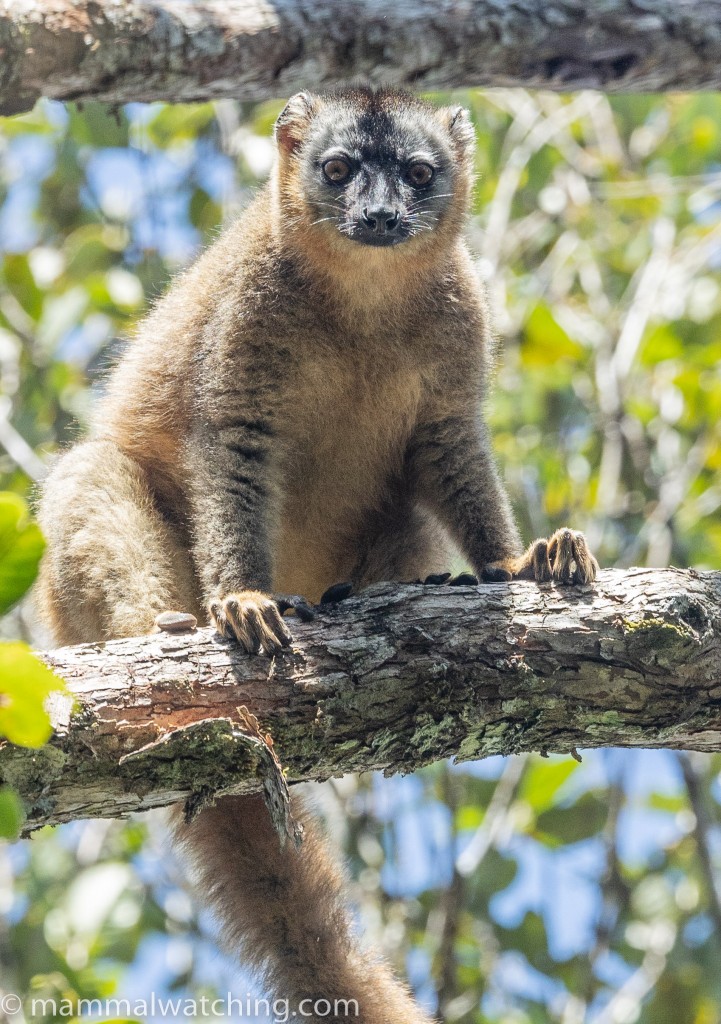
Red-fronted Brown Lemur (Eulemur rufifrons)
We could not find any Small-toothed Sportive Lemurs during several hours around the Vohipara Trail network, which we wandered around checking out known roosting holes. Patrick has rarely seen this species in the main section of the park, so this area – higher up and to the west – seems like a better place to search.
We did see Red-fronted Brown Lemurs and heard the park’s rather rare subspecies of Eastern Bamboo Lemur, though only one of the two guides saw it.
We stopped at the well known bat cave (more of an overhang) next to the road close here. Two species of bentwing bat have been recorded here: Miniopterus majori and M. sororculus.
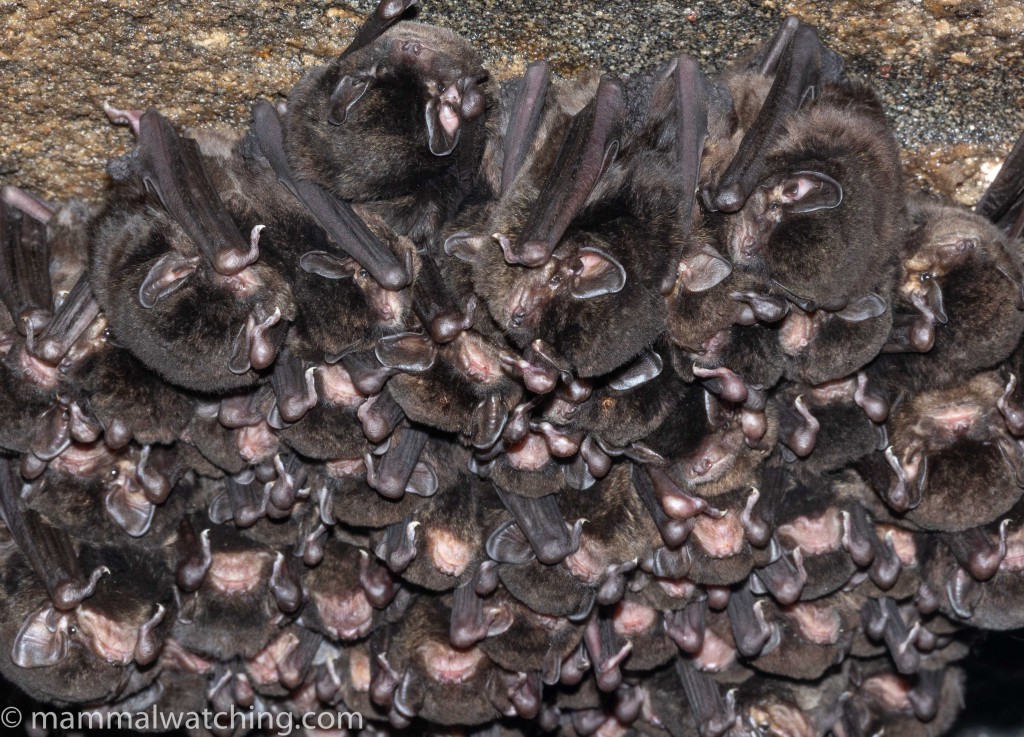
Major’s Bentwing Bats (Miniopterus majori)
I caught one of the bats and Steve Goodman confirmed it looked like Major’s Bentwing Bat.
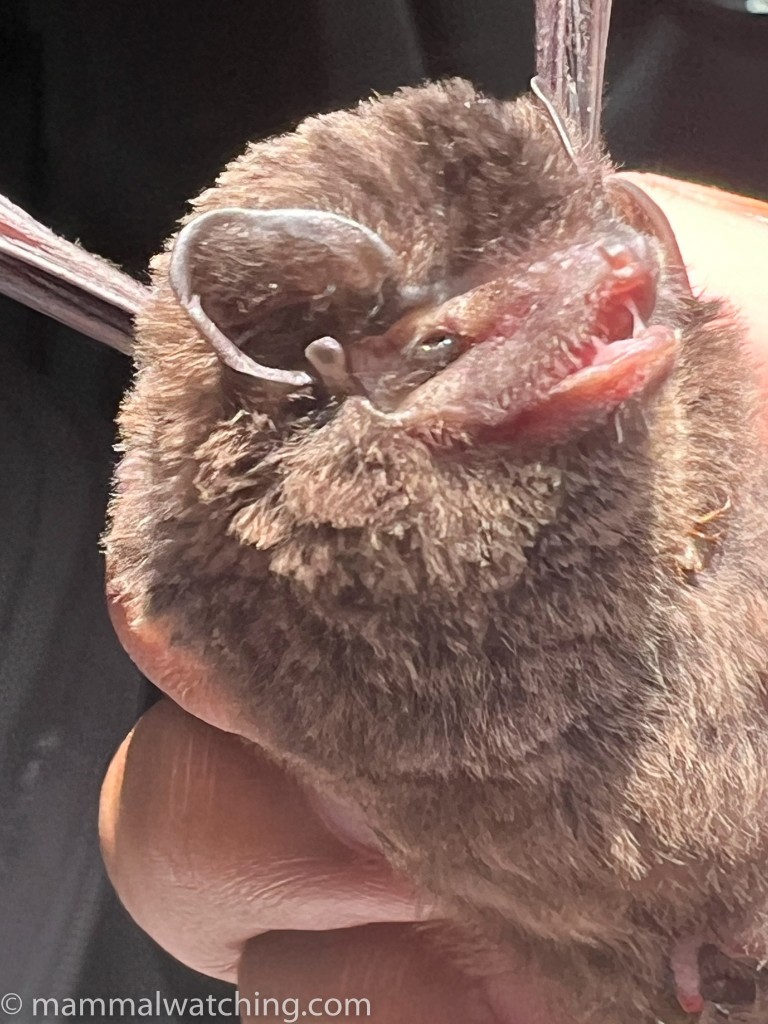
Major’s Bentwing (Miniopterus majori)
Spotlighting along the main road from a vehicle produced many dwarf lemurs. There appear to be at least two species of dwarf lemur in Ranomafana: Sibree’s Dwarf Lemur (Cheirogaleus sibreei) Groves’s Dwarf Lemur (C. grovesi). See here. I think we saw both.
Spotlighting along the main road that passes through the lower areas of the park we saw several distant dwarf lemurs that all looked similar.
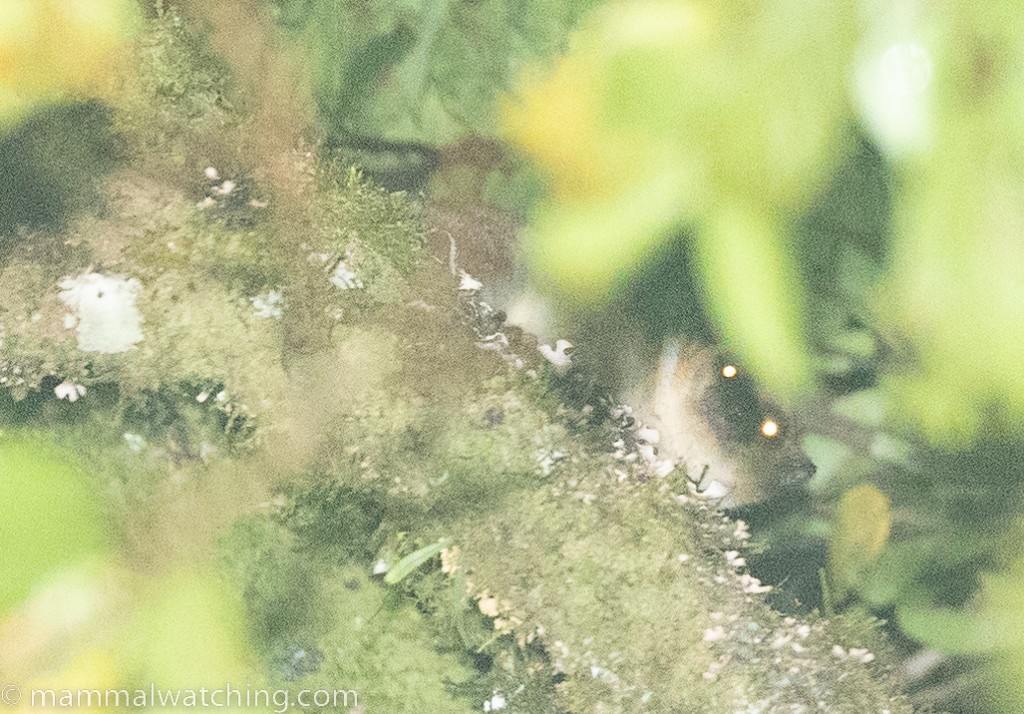
Sibree’s Dwarf Lemur (Cheirogaleus sibreei). I think.
I think this is Sibree’s Dwarf Lemur, based on colouration and the brief description in the Lynx guide.
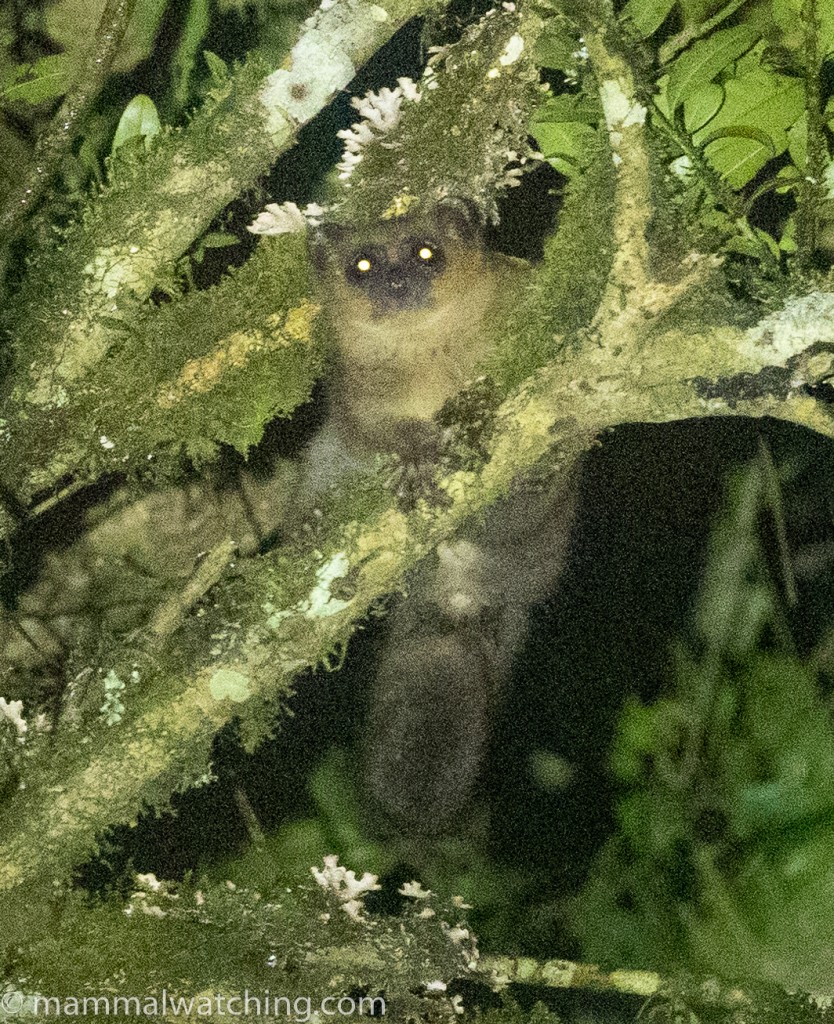
Sibree’s Dwarf Lemur (Cheirogaleus sibreei). I think.
Spotlighting in the higher section of the park – near the western boundary – produced many dwarf lemur species that, based on colouration, is Groves’s Dwarf Lemur.
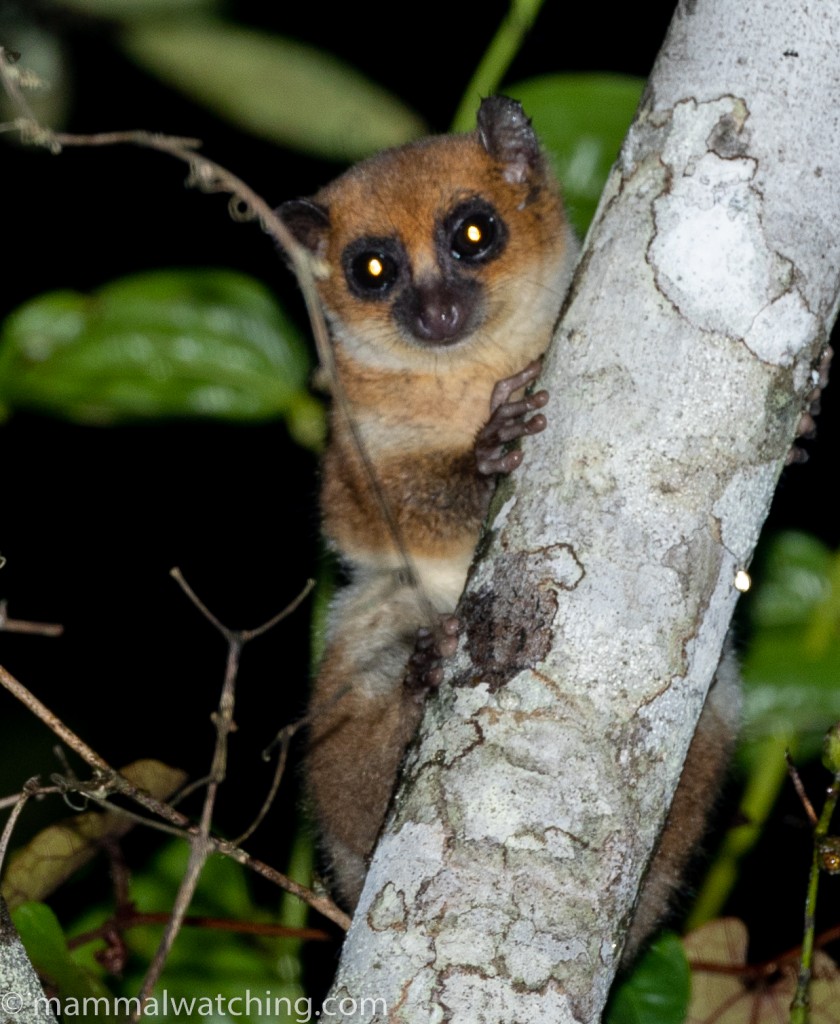
Grove’s Dwarf Lemur (Cheirogaleus grovesi). I think.
Tthe animals in this section of the park also all looked to be the same species, but different to those lower down. These lemurs appeared to have a more rufous head and more clearly defined pale patches on their noses.
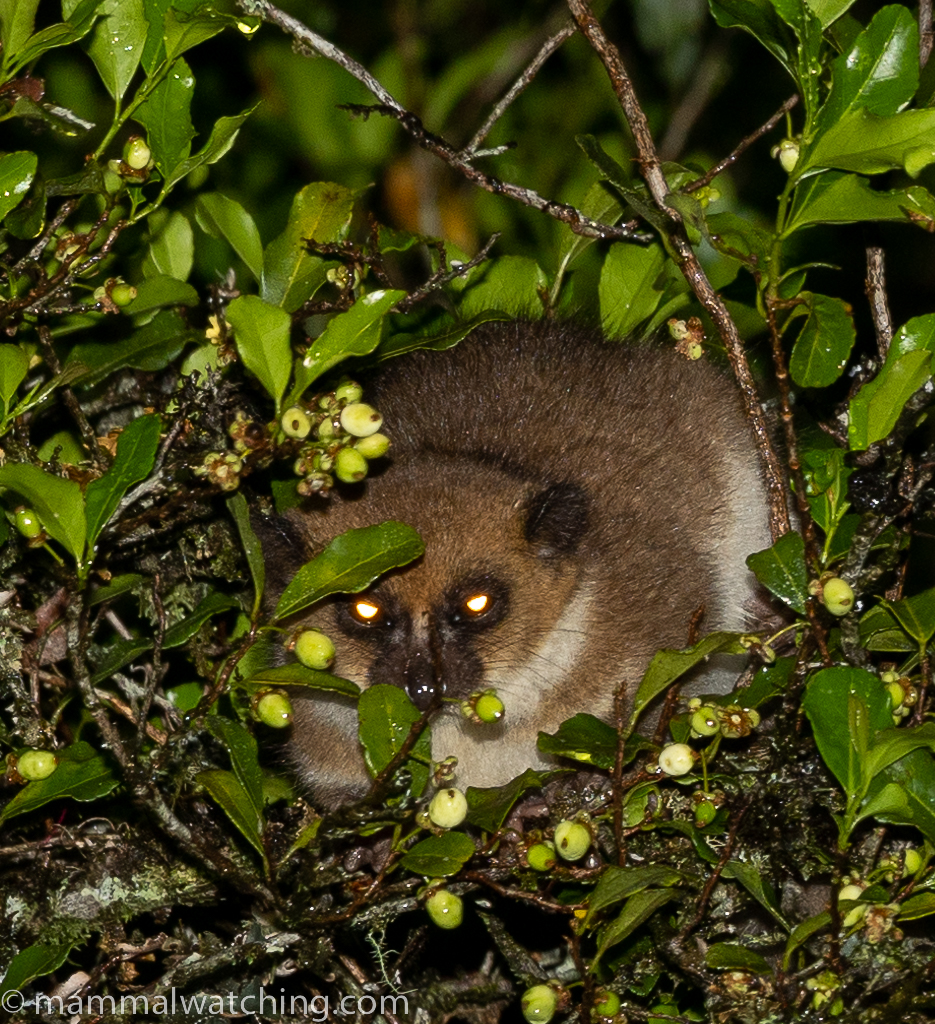
Grove’s Dwarf Lemur (Cheirogaleus grovesi). I think.
If anyone has any more thoughts I would love to hear them. Perhaps Nick Garbutt’s new book will reveal all.
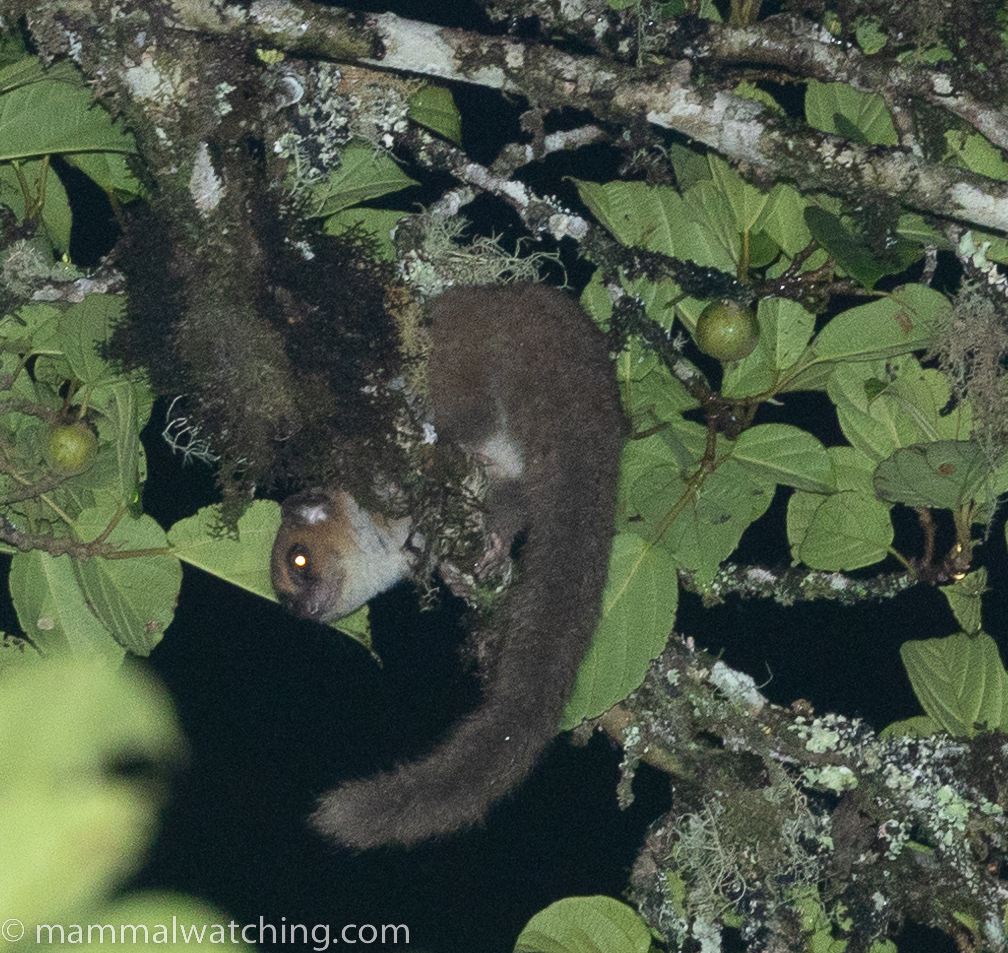
Grove’s Dwarf Lemur (Cheirogaleus grovesi). I think.
But the Fanaloka was my real target. Martin Royle saw a mother and her offspring in Ranomafana a few days before I arrived. Though Patrick has initially suggested we should try to camp fairly deep inside the park to look for them, Martin’s news caused us to rethink our strategy.
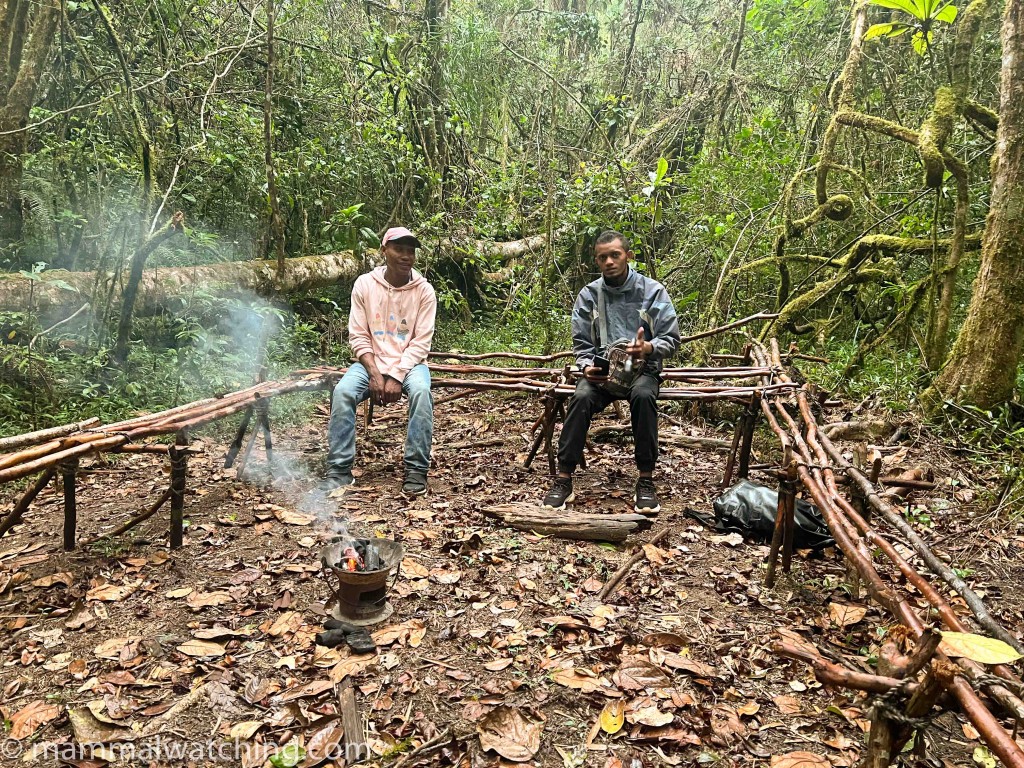
Martin had seen the animals on dusk at the Belle Vue lookout area. The viewpoint, a 30 minute brisk walk from the park entrance, is popular with tourists. We assumed the animals were scavenging for food and we headed up there in the late afternoon to barbecue some meat.
It rained heavily at dusk on our first evening. We saw Golden Bamboo Lemurs on the walk up to the viewpoint and some Peyrieras’s Woolly Lemurs at the viewpoint as the sun set. We also heard Black and White Ruffed Lemurs calling. No Fanaloka.
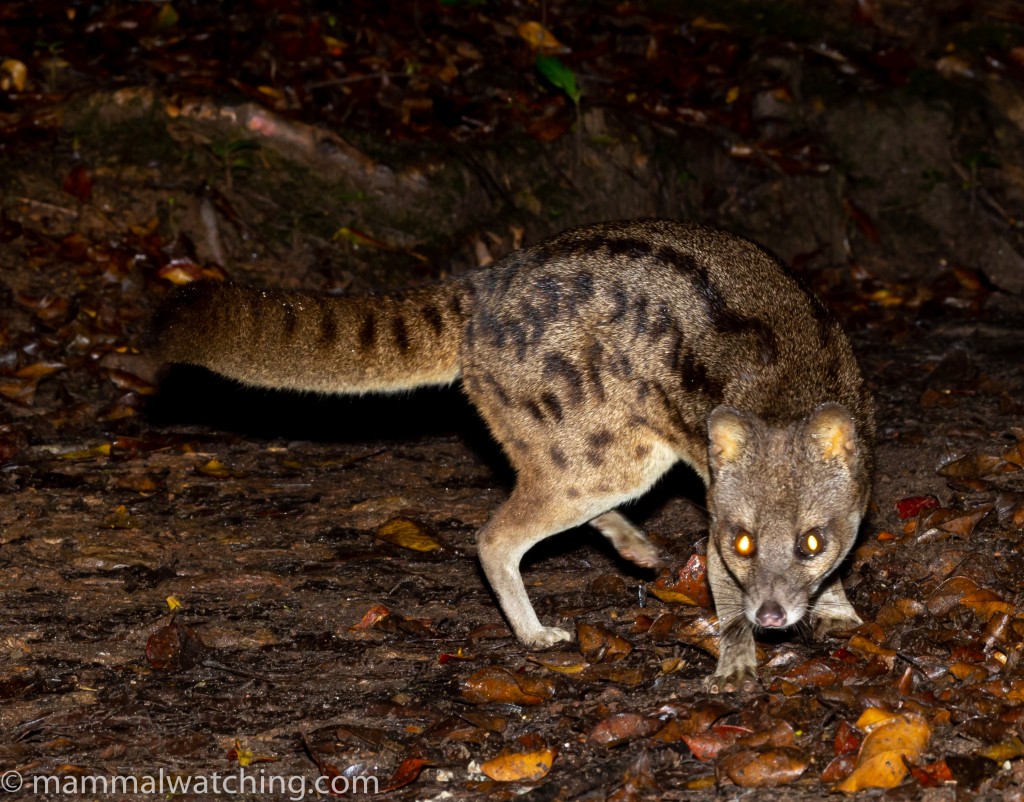
Fanaloka (Fossa fossana)
But the next evening – my last in Madagascar – we saw the same pair of animals that Martin Royle had seen. We watched them for 45 minutes as they scavenged along the trail, either oblivious or unworried about our presence. On several occasions they walked to within touching distance while I sat on the ground taking photographs. Fantastic!
We also saw a forest rat (nesomys) species at the view point in the afternooon but I did not get a good look or any photographs. There are two species in Ranomafana. The viewpoint is around 1000 metres above sea level. So it is the range of altitudinal overlap between Audebert’s and Eastern Forest Rat, albeit at the upper limit of the known elevational range of Nesomys audeberti. I recorded it as a tentative Eastern Forest Rat.
A very large bat flitting along the trail could only have been Commerson’s Leaf-nosed Bat.
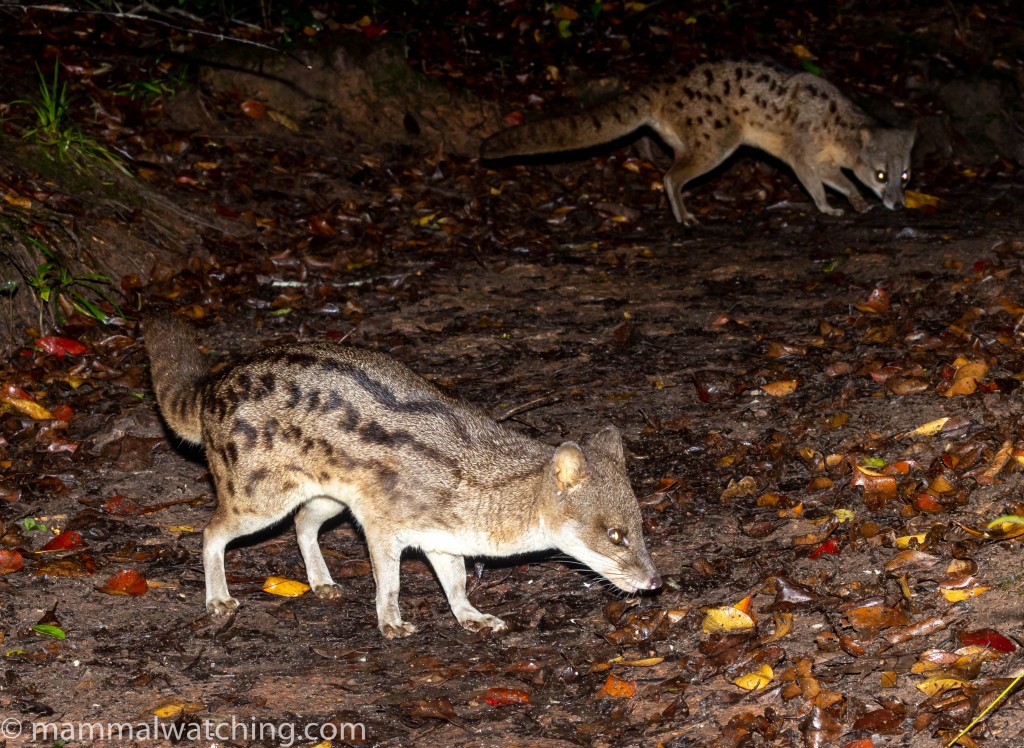
Fanaloka (Fossa fossana)
Walking back to the car we saw a Rufous Mouse Lemur. I was not looking carefully on the fast walk back (we needed to exit the park), but Martin Royle reported a Small-toothed Sportive Lemur along the trail, so perhaps they are more common in this part of the park than Patrick thought.
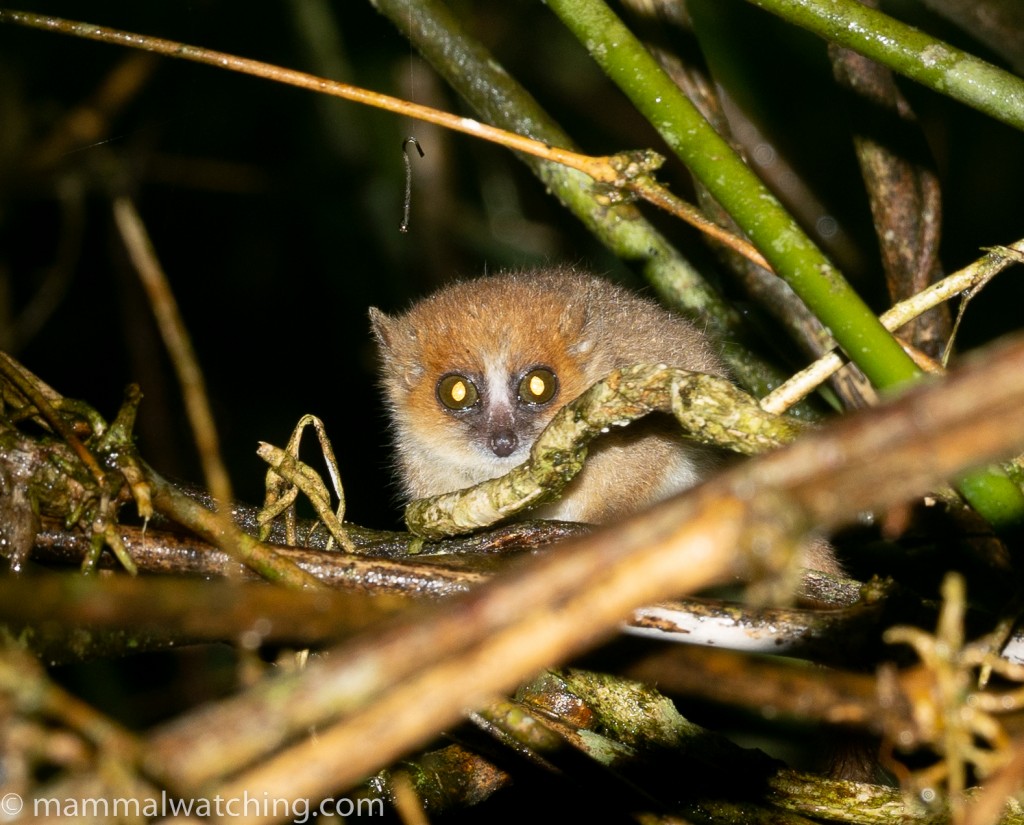
Rufous Mouse Lemur (Microcebus rufus)
The next morning we headed back to Tana. What started as a few days in search of two target mammals ended up seeing more than 20 species including 8 lifers But still no Fossa.
Thank you again Patrick Richard and all the local guides we used and for Steve Goodman for his ID expertise.
I will return.
Trip List
Greater Hedgehog Tenrec (Setifer setosus)
Tailless Tenrec (Tenrec ecaudatus)
Western Big-footed Mouse (Macrotarsomys bastardi)
Eastern Red Forest Rat (N.rufus) (?)
Jolly’s Mouse Lemur (Microcebus jollyae)
Grey Mouse-lemur (M.murinus)
Rufous Mouse Lemur (M.rufus)
Groves’s Dwarf Lemur (Cheirogaleus grovesi)
Geoffroy’s Dwarf Lemur (C.major)
Western Fat-tailed Dwarf Lemur (C.medius)
Sibree’s Dwarf Lemur (C.sibreei)
Pale Fork-marked Lemur (P.pallescens)
Red-tailed Sportive Lemur (L.ruficaudatus)
Golden Bamboo Lemur (Hapalemur aureus)
Red-fronted Brown Lemur (E.rufifrons)
Black-and-white Ruffed Lemur (Varecia variegata) (Heard only)
Peyrieras’ Woolly Lemur (Avahi peyrierasi)
Verreaux’s Sifaka (P.verreauxi)
Commerson’s Leaf-nosed Bat (Macronycteris commersonii)
Peter’s Sheath-tailed Bat (Paremballonura atrata)
Eastern Sucker-footed Bat (Myzopoda aurita)
Major’s Long-fingered Bat (M.majori)
Fanaloka (Fossa fossana)
19 species seen plus an unidentified forest rat and potentially three additional dwarf lemurs.
Lifers (and potential lifers) in bold
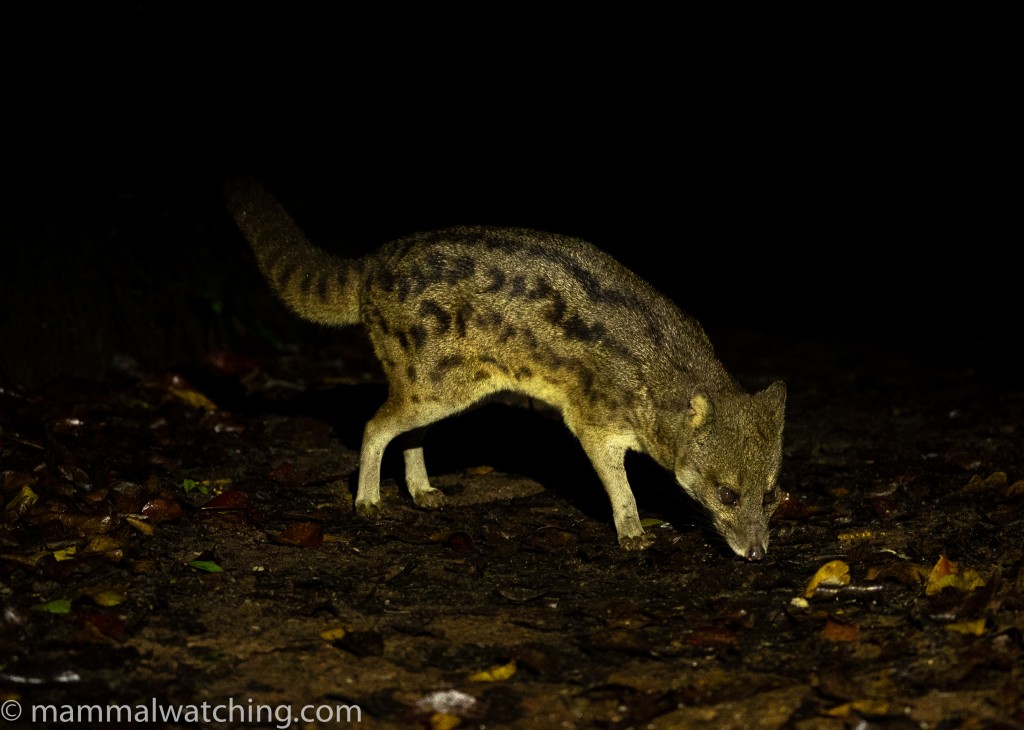
Fanaloka (Fossa fossan)
3 Comments
-
-
Jon Hall
Thanks so much Derek. That is very interesting and useful intel (and also good news about exaggerated reports of the demise of Madame Berthe’s). I will add a line to the report to alert people to this comment. Very interesting about those leaf bugs. Did you see Mirza coquereli there in 2019?
-
-
Samuel
Nice report again Jon but this time in an area more Classic to me. I did not know about the Kianjavato Forest that looks nice. Ranomafana is definitely a great place with so many lemur species that can be seen there both day and nigth. Il looks like the fanalouka is commonly seen there in the same place (this is also where we saw it a few years ago). Sad to hear Kirindy might not be as good as before… For sure, knowing Madagascar, the stop due to COVID probably did not help for nature protection and preventing logging. I was actually concerned for the silky sifaka situation but your northern report positively proved me I was wrong
Leave a Reply
You must be logged in to post a comment.


Derek Schuurman
Great reports on your recent Madagascar trip, Jon. A small group tour I arranged in October 2022 led by Daniel Austin (author of the Bradt Madagascar Guide, among other titles) enjoyed two separate sightings of Madame Berthe’s mouse lemur at Kirindy Forest. Daniel’s observations – which happened in the first week of October – are logged in iNaturalist. I included a photo taken by one of the participants, in this editorial just published in Madagascar Conservation & Development Journal: https://www.journalmcd.com/index.php/mcd/article/view/mcd.v17i1.6
They also saw Fosa during the day and again at night. However they did not see Giant jumping rat on that trip. The guides’ opinion views agree with yours in that, following the pandemic, sightings of many mammal species have been reduced at Kirindy, possibly due to a combination of persecution and rampant deforestation in Menabe Antimena, the Protected Area that includes Kirindy Forest.
When I last visited there in October 2019, Fosa, Boky-boky (Narrow-striped mongoose) and all of the nocturnal lemurs were easily observed – that is, with the exception of Madame Berthe’s mouse lemur. We searched Kirindy and Marofandilia with some of the area’s most talented guides, but dipped. They said it has an association with Flattid leaf bugs – I think it is partial to a secretion from those insects.
Thanks for sharing your brilliant reports.